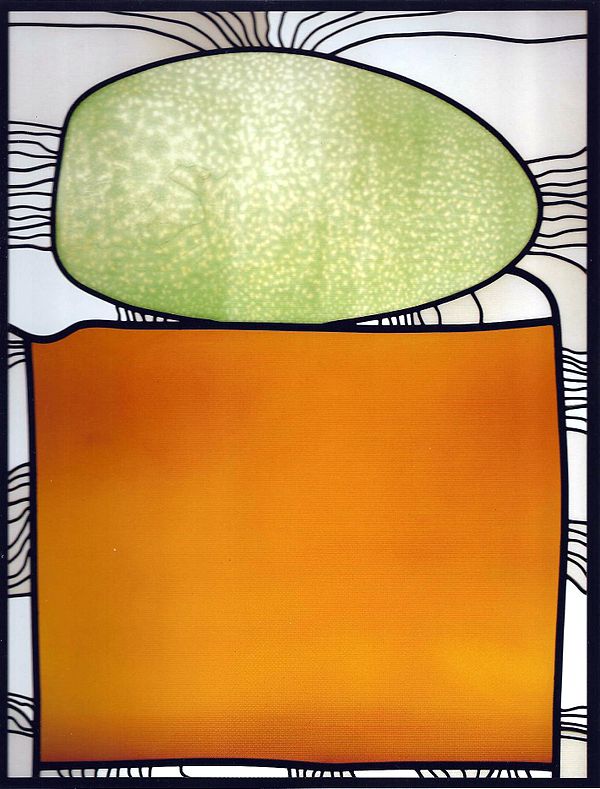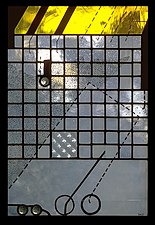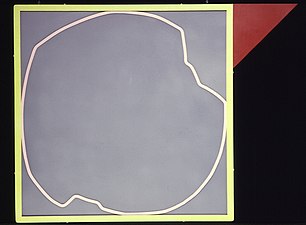
Louis Comfort Tiffany was an American artist and designer who worked in the decorative arts and is best known for his work in stained glass. He is the American artist most associated with the Art Nouveau and Aesthetic movements. He was affiliated with a prestigious collaborative of designers known as the Associated Artists, which included Lockwood de Forest, Candace Wheeler, and Samuel Colman. Tiffany designed stained glass windows and lamps, glass mosaics, blown glass, ceramics, jewelry, enamels, and metalwork. He was the first Design Director at his family company, Tiffany & Co., founded by his father Charles Lewis Tiffany.

The term stained glass can refer to coloured glass as a material or to works created from it. Throughout its thousand-year history, the term has been applied almost exclusively to the windows of churches and other significant religious buildings. Although traditionally made in flat panels and used as windows, the creations of modern stained glass artists also include three-dimensional structures and sculpture. Modern vernacular usage has often extended the term "stained glass" to include domestic lead light and objets d'art created from foil glasswork exemplified in the famous lamps of Louis Comfort Tiffany.

A grisaille is a painting executed entirely in shades of grey or of another neutral greyish colour. It is particularly used in large decorative schemes in imitation of sculpture. Many grisailles include a slightly wider colour range, like the Andrea del Sarto fresco illustrated. Paintings executed in brown are referred to as brunaille, and paintings executed in green are called verdaille.

Bernard van Orley, also called Barend or Barent van Orley, Bernaert van Orley or Barend van Brussel, was a versatile Flemish artist and representative of Dutch and Flemish Renaissance painting, who was equally active as a designer of tapestries and, at the end of his life, stained glass. Although he never visited Italy, he belongs to the group of Italianizing Flemish painters called the Romanists, who were influenced by Italian Renaissance painting, in his case especially by Raphael.

Gothic art was a style of medieval art that developed in Northern France out of Romanesque art in the 12th century AD, led by the concurrent development of Gothic architecture. It spread to all of Western Europe, and much of Southern and Central Europe, never quite effacing more classical styles in Italy. In the late 14th century, the sophisticated court style of International Gothic developed, which continued to evolve until the late 15th century. In many areas, especially Germany, Late Gothic art continued well into the 16th century, before being subsumed into Renaissance art. Primary media in the Gothic period included sculpture, panel painting, stained glass, fresco and illuminated manuscripts. The easily recognizable shifts in architecture from Romanesque to Gothic, and Gothic to Renaissance styles, are typically used to define the periods in art in all media, although in many ways figurative art developed at a different pace.

Maria Helena Vieira da Silva was a Portuguese abstract painter. She was considered a leading member of the European abstract expressionism movement known as Art Informel. Her works feature complex interiors and city views using lines that explore space and perspective. She also worked in tapestry and stained glass.
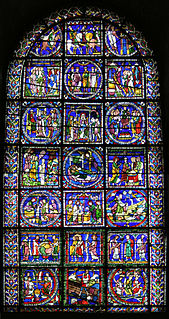
The term Poor Man's Bible has come into use in modern times to describe works of art within churches and cathedrals which either individually or collectively have been created to illustrate the teachings of the Bible for a largely illiterate population. These artworks may take the form of carvings, paintings, mosaics or stained-glass windows. In some churches a single artwork, such as a stained-glass window has the role of Poor Man's Bible while in others, the entire church is decorated with a complex biblical narrative that unites in a single scheme.

Leadlights, leaded lights or leaded windows are decorative windows made of small sections of glass supported in lead cames. The technique of creating windows using glass and lead came is discussed at came glasswork. The term leadlight could be used to describe all windows in which the glass is supported by lead, but traditionally and correctly, a distinction is made between stained glass windows and leadlights, the former being associated with the ornate painted images on windows of churches and other such works of architecture and the latter with the windows of vernacular commercial and domestic architecture and defined by its simplicity.

A revival of the art and craft of stained-glass window manufacture took place in early 19th-century Britain, beginning with an armorial window created by Thomas Willement in 1811–12. The revival led to stained glass windows becoming such a common and popular form of coloured pictorial representation that many thousands of people, most of whom would never commission or purchase a painting, contributed to the commission and purchase of stained-glass windows for their parish church.
Judith Schaechter is a Philadelphia-based artist known for her work in the medium of stained glass. Her pieces often use symbolism from stained glass and Gothic traditions, but the distorted faces and figures in her work recall a 20th century German Expressionist painting style and her subject matter is secular. Shaechter's work often involves images that might be considered disturbing such as death, disease, or violence. Early Schaechter pieces, for example, such as King of Maggots and Vide Futentes make use of memento mori, symbols of death found in church architecture during medieval times.

Stanislav Libenský and Jaroslava Brychtová were contemporary artists. Their works are included in many major modern art collections, such as the Metropolitan Museum of Art and the Victoria & Albert Museum.

Brian Clarke is a British architectural artist, painter and printmaker, known for his large-scale stained glass and mosaic projects, abstract and symbolist canvases, and collaborations with major figures in Modern and contemporary architecture.

Glass art refers to individual works of art that are substantially or wholly made of glass. It ranges in size from monumental works and installation pieces to wall hangings and windows, to works of art made in studios and factories, including glass jewelry and tableware.
Dieterich Spahn is a German-born American artist working in the fields of stained glass and painting. In a career spanning more than four decades he has produced roughly 370 stained glass commissions for places of worship, hospitals, universities and private residences throughout the United States. In addition to stained glass, Spahn continues to explore new media and techniques with his painting.

Robert Kehlmann is an artist and writer. He was an early spokesperson for evaluating glass art in the context of contemporary painting and sculpture. His glasswork has been exhibited worldwide and is the focus of numerous commentaries. Kehlmann's work can be found in museums and private collections in the United States, Europe and Asia. He has written books, articles, and exhibition reviews for publications in the U.S. and abroad. In 2014 the Rakow Research Library of The Corning Museum of Glass acquired Kehlmann's studio and research archives.
Peter Mollica is an American stained glass artist.
The Lindtmayer family was a Swiss family of artists specialising in glass painting.

Jan Rombouts the Elder or Jan Rombauts the Elder, was a Flemish Renaissance painter, glass painter, draftsman, printmaker and glass designer of a religious-themed oeuvre. Jan Rombouts was active in Leuven where he introduced the Renaissance innovations of Bernard van Orley and the Antwerp school.
Susan Stinsmuehlen-Amend is a glass and mixed media artist who lives and works in Ojai, California.
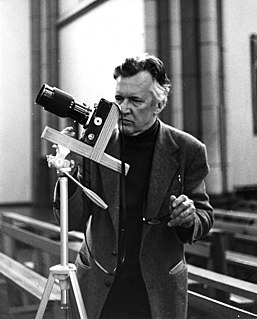
Robert Sowers was an American painter, photographer, stained glass artist, and seminal figure in the re-emergence of stained glass as an architectural art in the United States. His architectural glass commissions cover some 20 years from St George's Episcopal Church, Durham, New Hampshire (1955) to Stephen Wise Free Synagogue, New York (1975) and the blue cross window for Cathedral of the Immaculate Conception. In November 1953 he participated in the New Talent Exhibition at the Museum of Modern Art in New York City. He designed the vast American Airlines terminal glass facade at John F. Kennedy International Airport in 1958–59. It was demolished in 2008 to allow for an reorganization and expansion of their terminal. In addition to his glass commissions he wrote multiple magazine articles and published four books on stained glass, art, and architecture. He was an exceptional photographer documenting his own as well as other artist's glass work and spent many hours walking the streets and parks of Manhattan and Brooklyn with camera in hand. A posthumous volume of his B/W photographs was published in 1990. In 1979 he began a series of black and white paintings that eventually transitioned into color. These were based on his 35mm slides of derelict industrial landscapes, city parks, and botanical gardens of New York City and Tanglewood in the Berkshires. He sold his first painting through OK Harris Gallery, and reviewed the first printing of his fourth book almost simultaneously with his untimely death in March 1990. His archives are located at the Rakow Research Library, Corning Museum of Glass, Corning, New York.
